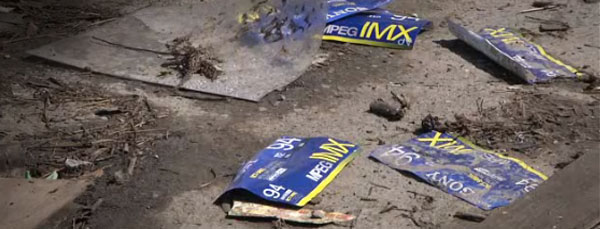Transforming the Universe
Cachu Hwch *
* It’s all gone wrong

On 10th of March of 2011, Howard Stringer, then Sony’s chief executive, left Tokyo in a wheelchair. A slipped disk in his back required emergency surgery, and he was flying home to New York for the procedure.
What the Welshman didn’t know was that his situation, already painful, was about to become even worse. So bad indeed that he would have to step back from CEO the next year, and that his back surgery would have to wait!
When his jet landed the next day, he learned that the biggest earthquake in memory and a devastating tsunami had just struck the east coast of Japan.
Sony factories in the Fukushima and Miyagi prefectures, 8 in total, immediately halted production. Those close to the shore were so badly damaged by flooding that it took over one year to resume production.
Tragedy, however, would also transform Sony in unexpected ways…
Connecting the Dots
Fast forward to end of 2016: As I was putting the final touches on Treasured 4, I was a bit annoyed.
The rewritten “engine”, powered by libavcodec, was really shining. I could finally display those high-end Sony XAVC and Canon XF-AVC frames in all their 12-bit glory.
However, my redesign had also a few drawbacks: Some video formats would no longer “render”, due to lack of libavcodec equivalent to some proprietary QuickTime codec.
REDCODE and Sony HDCAM-SR fell into this category, and that was really annoying.
I quickly made some statistics of last years requests using those formats, and decided it wouldn’t be too significant. HDCAM-SR numbers indicated that the format was about to disappear, after decreasing for several years in a row.
Still, we had Sony at both ends of the spectrum: On the head, Sony XAVC, strongly leading the 4K pack; on the tail the dwindling Sony HDCAM-SR.
I couldn’t help but remember what had happened 5 years earlier, the flooded factories, the production lines stopped for months, and I made the connection:
Think a moment about Shiva, the Hindu god of creation and destruction, who creates, protects and transforms the universe… Tragedies always have a flip side – and don’t get me wrong, with over 20,000 casualties we’re better off without tragedy – and for Sony the flooded factories may have been a catalyst, that accelerated transition to new technologies.

But before we analyze the consequences over the years, let me tell you first the inside story of that spring and summer of 2011.
The Twilight of the Tapes
When production of HDCAM-SR tapes suddenly stopped in March 2011, professional video tapes were the medium of choice for prime time, episodic TV production.
Although Sony communicated that they expected a three months downtime, the folks in Hollywood, with only two weeks of HDCAM-SR tape supply and a shooting season about to begin, immediately saw the Sendai factory flooding as an existential threat, and started to look for alternatives.
Some of them were already engaged in a tape HDCAM workflow and had no choice but to frantically purchase all existences of HDCAM-SR tape on sale, to secure production until end of season. Tape prices on gray market surged and despite efforts by Sony to alleviate distribution bottlenecks, stocks evaporated in a few weeks.

For many other productions, there was still a plan B: Accelerate the move to tapeless workflow.
Others have explained in detail the immediate impact on the industry of HDCAM-SR tape shortage. To summarize, the shock wave travelled from production down to post-production and delivery:
- Japan tsunami accelerated a trend that was already happening: the use of tapeless cameras.
- Forced to embrace the new ARRI, RED, and other tapeless cameras, the production houses had their fears quickly dispelled: The result was flawless, technology was ready!
- Post production houses were now receiving files instead of tapes. Despite huge investments in SR decks, they were forced to adapt.
- For delivery of masters to broadcasters, HDCAM-SR tape, the standardized format, was suddenly questioned. If most deliveries were still done in tape, master file transfers through fiber optic lines became common. The future was here.
- Archiving, on the other end, moves at a slower pace. Transition from film to HDCAM-SR was still recent in 2011, but shortage raised the question.
And with all that, the summer passed quickly…
Gloomy Future
In October, seven months after the disaster, Sony finally managed to restart production and to resume shipments of HDCAM-SR tapes.
But so much effort would hardly be rewarded.
Productions that had done the switch during summer would no longer need the tapes. Those who had purchased a supply of tapes in the aftermath of the disaster would not need them either, and had already planned to switch to tapeless the next season.
In years to come, Sony would continue to manufacture tapes, but the writing was now on the wall.
With the sudden decline of a very profitable business that otherwise would have enjoyed several more years of bonanza, and the inevitable loss of dominance in professional video industry, Sony was facing a gloomy future.

Of course, any attempt to regain a dominant position had not only to address the 2011 events, but also to envision the future of professional video, and deliver the new end-to-end solution, a kind of HDCAM-SR for 2015-2020 if you will.
In response to that challenge, Sony correctly identified the opportunities born out of crisis:
- What will replace HDCAM-SR as a standard for post and delivery? Getting rid of HDCAM has opened the eyes of the industry on the importance of a standard medium. Let’s design a solution that can become the new standard!
- 4K is about to happen. Let’s embrace it!
- Professional file-based workflows have specific needs (quality, bitrate, grading, metadata, interoperability, …) Let’s use the appropriate technology: AVC/H.264 and MXF containers
2011 is reaching an end, and now Sony has a plan…
Resurrection
On October 30, 2012, Sony unveiled the XAVC recording format!
In the past 12 months the tape industry had been disrupted and chaos was looming.
Still, someone had to be the first to make a compelling offer, and start building a new order.
Sony had just done it!
Let’s speculate a bit:
In what position would Sony be today in the professional video markets if not for 2011 flooding?
I believe that they wouldn’t be enjoying a two years lead over Canon, healthy profits, and such a dominant position.
Profitable HDCAM line would have slowed them, the risk of cannibalizing their tape business would have discouraged innovation.
Sure, they would have moved to 4K AVC, but too bland too late. They wouldn’t lead.
A corollary to the Innovator’s dilemma is that companies with biggest investments in old and current technologies are the least inclined to invent the next generation of products.
In 2011, Sony tape business was probably in the middle of the “milking” phase. Sony was definitively not the natural innovator, but the tsunami changed everything.
Sony video division had to face the perfect storm, but with the proper timing, vision and resolve, against all odds, they managed an impressive turnabout. A good lesson for the competitors!

